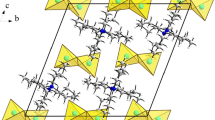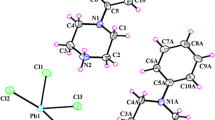Abstract
The AC conductivity of nickel phthalocyanine octacarboxylic acid was investigated from 100 Hz to 1 MHz and temperature from 290 to 423 K. The AC conductivity was found to vary with frequency (σ(f)) and form two dispersion regions; the associated exponent factor “s” values were found to vary from 1.17 to 1.34 and from 0.42 to 0.67 (< 1). The value and temperature dependent of s are found in agreement with conduction mechanism models of large-polaron tunneling and the correlated barrier hopping, at the first and the second regions, respectively. The real and the imaginary parts of the dielectric constant were observed to decrease as the frequency increases indicating the pronounce contribution of low-frequency polarization mechanisms. Furthermore, the activation free energy ∆F, enthalpy ∆H, and entropy ∆S of the sample were calculated as well.












Similar content being viewed by others
References
M. Raïssi, S. Leroy-Lhez, B. Ratier, Enhanced photocurrent and stability of organic solar cells using solution-based TS-CuPc interfacial layer. Org. Electron. Phys. Mater. Appl. 37, 183–189 (2016). https://doi.org/10.1016/j.orgel.2016.06.030
M.M. Al-Amar, K.J. Hamam, G. Mezei, R. Guda, N.M. Hamdan, C.A. Burns, A new method to improve the lifetime stability of small molecule bilayer heterojunction organic solar cells. Sol. Energy Mater. Sol. Cells. 109, 270–274 (2013). https://doi.org/10.1016/j.solmat.2012.11.006
M.M. Al-Amar, K.J. Hamam, G. Mezei, R. Guda, C.A. Burns, Stability and degradation of unencapsulated CuPc bilayer heterojunction cells under different atmospheric conditions. Sol. Energy Mater. Sol. Cells. 121, 152–156 (2014). https://doi.org/10.1016/j.solmat.2013.11.006
C.L. Wu, Y. Chen, Hydroxyethyl cellulose doped with copper(II) phthalocyanine-tetrasulfonic acid tetrasodium salt as an effective dual functional hole-blocking layer for polymer light-emitting diodes. Opt. Mater. (Amst). 69, 38–48 (2017). https://doi.org/10.1016/j.optmat.2017.04.004
Y. Chen, Q. Wang, J. Chen, D. Ma, D. Yan, L. Wang, Organic semiconductor heterojunction as charge generation layer in tandem organic light-emitting diodes for high power efficiency. Org. Electron. Phys. Mater. Appl. 13, 1121–1128 (2012). https://doi.org/10.1016/j.orgel.2012.03.013
H. Jiang, J. Ye, P. Hu, F. Wei, K. Du, N. Wang, T. Ba, S. Feng, C. Kloc, Fluorination of metal phthalocyanines: single-crystal growth, efficient N-channel organic field-effect transistors, and structure-property relationships, Sci. Rep. 4 (2014). https://doi.org/10.1038/srep07573
M.E. Roberts, A.N. Sokolov, Z. Bao, Material and device considerations for organic thin-film transistor sensors. J. Mater. Chem. 19, 3351–3363 (2009). https://doi.org/10.1039/b816386c
O.A. Melville, B.H. Lessard, T.P. Bender, Phthalocyanine-based organic thin-film transistors: a review of recent advances. ACS Appl. Mater. Interfaces. 7, 13105–13118 (2015). https://doi.org/10.1021/acsami.5b01718
E.S. Muckley, C.B. Jacobs, K. Vidal, N.V. Lavrik, B.G. Sumpter, I.N. Ivanov, Multi-mode humidity sensing with water-soluble copper phthalocyanine for increased sensitivity and dynamic range, Sci. Rep. 7 (2017). https://doi.org/10.1038/s41598-017-10401-2
J.C. Bommer, J.D. Spikes, Phthalocyanines: properties and applications. Photochem. Photobiol. 53, 419–419 (1991). https://doi.org/10.1111/j.1751-1097.1991.tb03651.x
J. Nackiewicz, A. Suchan, M. Kliber, Octacarboxyphthalocyanines—compounds of interesting spectral, photochemical and catalytic properties. Chemik. 68, 373–376 (2014)
A.M. Saleh, S.M. Hraibat, R.-L. Kitaneh, M.M. Abu-Samreh, S.M. Musameh, Dielectric response and electric properties of organic semiconducting phthalocyanine thin films. J. Semicond. 33, 082002 (2012). https://doi.org/10.1088/1674-4926/33/8/082002
R.M.L. Kitaneh, A.M. Saleh, R.D. Gould, Ac electrical parameters of Al-ZnPc-Al organic semiconducting films. Cent. Eur. J. Phys. 4, 87–104 (2006). https://doi.org/10.1007/s11534-005-0008-4
S.M. Hraibat, R.M.L. Kitaneh, M.M. Abu- Samreh, A.M. Saleh, AC-electronic and dielectric properties of semiconducting phthalocyanine compounds: a comparative study, J. Semicond. 34 (2013). https://doi.org/10.1088/1674-4926/34/11/112001
M.M. El-Nahass, A.M. Farid, K.F. Abd El-Rahman, H.A.M. Ali, Ac conductivity and dielectric properties of bulk tin phthalocyanine dichloride (SnPcCl2). Phys. B Condens. Matter. 403, 2331–2337 (2008). https://doi.org/10.1016/j.physb.2007.12.015
A.A. Atta, AC conductivity and dielectric measurements of bulk magnesium phthalocyanine (MgPc). J. Alloys Compd. 480, 564–567 (2009). https://doi.org/10.1016/j.jallcom.2009.01.124
I.M. Soliman, M.M. El-Nahass, Y. Mansour, Electrical, dielectric and electrochemical measurements of bulk aluminum phthalocyanine chloride (AlPcCl). Solid State Commun. 225, 17–21 (2016). https://doi.org/10.1016/j.ssc.2015.10.011
G. Mezei, A.R. Venter, J.W. Kreft, A.A. Urech, N.R. Mouch, Monomeric, not tetrameric species are responsible for the colossal dielectric constant of copper phthalocyanine derived from pyromellitic dianhydride. RSC Adv. 2, 10466–10469 (2012). https://doi.org/10.1039/c2ra21634e
K.J. Hamam, M.M. Al-Amar, G. Mezei, R. Guda, C. Burns, High dielectric constant response of modified copper phthalocyanine. J. Mol. Liq. 199, 324–329 (2014). https://doi.org/10.1016/j.molliq.2014.09.029
V.S.P.K. Neti, J. Wang, S. Deng, L. Echegoyen, High and selective CO2 adsorption by a phthalocyanine nanoporous polymer, J. Mater. Chem. A. 3 (2015) 10284–10288. https://doi.org/10.1039/c5ta00587f.
M.H. Salehi, A.R. Karimi, Novel octa-substituted metal (II) phthalocyanines bearing 2,6-di- tert -buthylphenol groups: synthesis, characterization, electronic properties, aggregation behavior and their antioxidant activities as stabilizer for polypropylene and high density polyeth. Polym. Degrad. Stab. (2018). https://doi.org/10.1016/j.polymdegradstab.2018.03.005
R. Seoudi, G.S. El-Bahy, Z.A. El Sayed, FTIR, TGA and DC electrical conductivity studies of phthalocyanine and its complexes. J. Mol. Struct. 753, 119–126 (2005). https://doi.org/10.1016/j.molstruc.2005.06.003
K. Lily, K. Kumari, R.N.P. Prasad, Choudhary, Impedance spectroscopy of (Na0.5Bi0.5)(Zr0.25Ti0.75)O3lead-free ceramic. J. Alloys Compd. 453, 325–331 (2008). https://doi.org/10.1016/j.jallcom.2006.11.081
A. Kumar, N.M. Murari, R.S. Katiyar, Investigation of dielectric and electrical behavior in Pb(Fe0.66W0.33)0.50Ti0.50O3thin films by impedance spectroscopy. J. Alloys Compd. 469, 433–440 (2009). https://doi.org/10.1016/j.jallcom.2008.01.130
E. Barsoukov, J.R. Macdonald, Impedance Spectroscopy: Theory, Experiment, and Applications, 2nd edn. (Wiley, Hoboken, 2005), Applications of Impedance Spectroscopy, pp. 232–258. https://doi.org/10.1002/0471716243
F. Salman, R. Khalil, H. Hazaa, Impedance measurements of some silver ferro-phosphate glasses. Adv. Mater. Lett. 7, 593–598 (2016). https://doi.org/10.5185/amlett.2016.6175
A.K. Jonscher, Dielectric relaxation in solids, J. Phys. D Appl. Phys. 32 (1999). https://doi.org/10.1088/0022-3727/32/14/201
K.C. Kao, Dielectric phenomena in solids (Elsevier, London, 2004), Electrical Conduction and Photoconduction, p. 381. https://doi.org/10.1016/B978-0-12-396561-5.X5010-5
K. Funke, Jump relaxation in solid ionic conductors, Solid State Ionics. 28–30 (1988) 100–107. https://doi.org/10.1016/S0167-2738(88)80015-8
K. Funke, Jump relaxation model and coupling model—a comparison, J. Non. Cryst. Solids. 172–174 (1994) 1215–1221. https://doi.org/10.1016/0022-3093(94)90646-7
V. Bobnar, A. Levstik, C. Huang, Q.M. Zhang, Intrinsic dielectric properties and charge transport in oligomers of organic semiconductor copper phthalocyanine, Phys. Rev. B Condens. Matter Mater. Phys. 71 (2005). https://doi.org/10.1103/PhysRevB.71.041202
M. Gou, X. Yan, Y. Kwon, T. Hayakawa, M.A. Kakimoto, T. Goodson, High frequency dielectric response in a branched phthalocyanine. J. Am. Chem. Soc. 128, 14820–14821 (2006). https://doi.org/10.1021/ja063796w
Y.A. Vidadi, L.D. Rozenshtein, E.A. Christyakov, Hopping and band conductivities in organic semiconductors. Sov. Phys. Solid State 11, 173–175 (1969)
M.M. EL-Nahass, A.F. EL-Deeb, F. Abd-El-Salam, Influence of temperature and frequency on the electrical conductivity and the dielectric properties of nickel phthalocyanine. Org. Electron. Phys. Mater. Appl. 7, 261–270 (2006). https://doi.org/10.1016/j.orgel.2006.03.007
S.K. Arya, S.S. Danewalia, K. Singh, Frequency independent low-: K lithium borate nanocrystalline glass ceramic and glasses for microelectronic applications. J. Mater. Chem. C. 4, 3328–3336 (2016). https://doi.org/10.1039/c5tc03364k
T.G.A. Malik, M.E. Kassεµb, N.S. Alyc, S.M. Kηalil, AC conductivity of cobalt phthalocyanine. Acta Phys. Pol. A. 81, 675–680 (1992). https://doi.org/10.12693/APhysPolA.81.675
S.A. James, A.K. Ray, J. Silver, Dielectric and optical studies of sublimed MoOPc films. Phys. Status Solidi. 129, 435–441 (1992). https://doi.org/10.1002/pssa.2211290213
S. Murugavel, M. Upadhyay, A.C. conduction in amorphous semiconductors. J. Indian Inst. Sci. 91, 303–317 (2011). https://doi.org/10.1080/00018738700101971
A.R. Long, Frequency-dependent loss in amorphous semiconductors. Adv. Phys. 31, 553–637 (1982). https://doi.org/10.1080/00018738200101418
M. Pollak, T.H. Geballe, Low-frequency conductivity due to hopping processes in silicon. Phys. Rev. 122, 1742–1753 (1961). https://doi.org/10.1103/PhysRev.122.1742
I.G. Austin, N.F. Mott, Polarons in crystalline and non-crystalline materials. Adv. Phys. 50, 757–812 (2001). https://doi.org/10.1080/00018730110103249
A.R. Long, N. Balkan, W.R. Hogg, R.P. Ferrier, A.C. loss in sputtered hydrogenated amorphous germanium measurements at around liquid-nitrogen temperatures. Philos. Mag. B. 45, 497–518 (1982). https://doi.org/10.1080/13642818208246415
M.M. Abdel-Kader, M.A.F. Basha, G.H. Ramzy, A.I. Aboud, Thermal and ac electrical properties of N-methylanthranilic acid below room temperature. J. Phys. Chem. Solids 117, 13–20 (2018). https://doi.org/10.1016/j.jpcs.2018.02.007
D.P. Almond, G.K. Duncan, A.R. West, The determination of hopping rates and carrier concentrations in ionic conductors by a new analysis of ac conductivity. Solid State Ionics. 8, 159–164 (1983). https://doi.org/10.1016/0167-2738(83)90079-6
M.D. Earle, Electrons and holes in semiconductors. J. Franklin Inst. 252, 95 (1951). https://doi.org/10.1016/0016-0032(51)91102-7
R.G. Chambers, The free-electron model, in Electronics in Metals and Semiconductors. Physics and its Application, 1st edn. (Springer, New Delhi, 1990). https://doi.org/10.1007/978-94-009-0423-1_1
B. Köksoy, M. Aygün, A. Çapkin, F. Dumludağ, M. Bulut, Electrical and gas sensing properties of novel cobalt(II), copper(II), manganese(III) phthalocyanines carrying ethyl 7-oxy-4,8-dimethylcoumarin-3-propanoate moieties. J. Porphyr. Phthalocyanines. (2018). https://doi.org/10.1142/S1088424618500153
E. Yabaş, M. Sülü, F. Dumludag, A.R. Özkaya, B. Salih, Ö Bekaroglu, Electrical and electrochemical properties of double-decker Lu(III) and Eu(III) phthalocyanines with four imidazoles and N-alkylated imidazoles. Polyhedron. 42, 195–205 (2012). https://doi.org/10.1016/j.poly.2012.05.020
P.B. Macedo, C.T. Moynihan, R. Bose, Role of Ionic diffusion in polarization in vitreous ionic conductors. Phys. Chem. Glas. 13, 171–179 (1972). https://doi.org/10.4236/ns.2014.66038
S. Glasstone, K.J. Laidler, H. Eyring, The Theory of Rate Processes: The Kinetics of I Chemical Reactions, Viscosity, Diffusion and Electrochemical Phenomena, 1st edn. (McGraw-Hill, New York, 1941), pp. 13–15, https://doi.org/10.1038/149509a0 (introduction)
H. Eyring, Viscosity, plasticity, and diffusion as examples of absolute reaction rates. J. Chem. Phys. 4, 283–291 (1936). https://doi.org/10.1063/1.1749836
K.K. Srivastava, A. Kumar, O.S. Panwar, K.N. Lakshminarayan, Dielectric relaxation study of chalcogenide glasses. J. Non. Cryst. Solids. 33, 205–224 (1979). https://doi.org/10.1016/0022-3093(79)90050-4
Acknowledgements
Gellert Mezei would like to acknowledge the donors of the American Chemical Society Petroleum Research Fund (ACS PRF) for their generous support of this research under Grant number 52907-ND10.
Author information
Authors and Affiliations
Corresponding author
Electronic supplementary material
Below is the link to the electronic supplementary material.
Rights and permissions
About this article
Cite this article
Hamam, K.J., Mezei, G., Khattari, Z. et al. Temperature and frequency effect on the electrical properties of bulk nickel phthalocyanine octacarboxylic acid (Ni-Pc(COOH)8). Appl. Phys. A 125, 7 (2019). https://doi.org/10.1007/s00339-018-2147-7
Received:
Accepted:
Published:
DOI: https://doi.org/10.1007/s00339-018-2147-7




